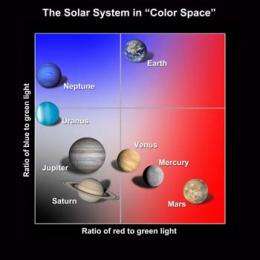Searching for alien earths with planet colors

Earth is invitingly blue. Mars is angry red. Venus is brilliant white. Astronomers have learned that a planet's "true colors" can reveal important details. For example, Mars is red because its soil contains rusty red stuff called iron oxide. And the famous tint of our planet, the "blue marble"? It's because the atmosphere scatters blue light rays more strongly than red ones. Therefore the atmosphere looks blue from above and below.
Planets around other stars probably exhibit a rainbow of colors every bit as diverse as those in our solar system. And astronomers would like to eventually harness color to learn more about exoplanets. Are they rocky or gaseous — or earthlike?
In a study recently accepted for publication in The Astrophysical Journal, a team led by NASA astronomer Lucy McFadden and UCLA graduate student Carolyn Crow describe a simple way to distinguish between the planets of our solar system based on color information. Earth, in particular, stands out clearly among the planets, like a blue jay in a flock of seagulls.
"The method we developed separates the planets out," Crow says. "It makes Earth look unique."
This suggests that someday, when we have the technology to gather light from individual exoplanets, astronomers could use color information to identify earthlike worlds. "Eventually, as telescopes get bigger, there will be the light-gathering power to look at the colors of planets around other stars," McFadden says. "Their colors will tell us which ones to study in more detail."
Earth the Exoplanet
The project began in 2008, when Crow teamed up with McFadden, her faculty mentor at the University of Maryland in College Park. McFadden currently heads university and post-doctoral programs at NASA's Goddard Space Flight Center in Greenbelt, Maryland.
New color information about Earth, the moon, and Mars became available, thanks to NASA's Deep Impact spacecraft. En route to a planned encounter this November with Comet 103P/Hartley 2, Deep Impact observed Earth. The idea was to determine what our home looks like to alien astronomers and eventually use that insight to figure out how to spot earthlike worlds around other stars.
As Deep Impact cruised through space, its High Resolution Instrument (HRI) measured the intensity of Earth's light. HRI is an 11.8-inch (30 cm) telescope that feeds light through seven different color filters mounted on a revolving wheel. Each filter samples the incoming light at a different portion of the visible-light spectrum, from ultraviolet and blue to red and near-infrared. On May 28, 2008, Deep Impact even caught a glimpse of the moon's light as it crossed in front of Earth. Later, in 2009, HRI scoped Mars.
McFadden wondered what combination of color information from the filters would best distinguish Earth from the other planets and moons of the solar system. She recruited Crow to work on the project. Eight other researchers from NASA, the University of Maryland, the University of Washington (Seattle), and the Johns Hopkins University Applied Physics Lab also joined the team.
The Magic Mix
The Deep Impact color data covered Earth, the moon, and Mars. The relative amounts of light passing through the filters vary for each planet or moon, providing a kind of color fingerprint. To this the team added existing color information about Mercury, Venus, Jupiter, Saturn, Uranus, Neptune, and Saturn's moon Titan.
A simple side-by-side comparison of color data on all the major planets was a confusing mess. The team finally found a combination of three different filters — one in the blue, one in the green, and one in the red — that highlights the differences between the planets.
On a special "color-color" diagram the team created, the planets cluster into groups based on similarities in the wavelengths of sunlight that their surfaces and atmospheres reflect. The gas giants Jupiter and Saturn huddle in one corner, Uranus and Neptune in a different one. The rocky inner planets Mars, Venus, and Mercury cluster off in their own corner of "color space."
But Earth is the true loner in color space. Its uniqueness traces to two factors. One is the scattering of blue light by the atmosphere. This is called Rayleigh scattering, after the English scientist who discovered it.
The other reason Earth stands out in color space is because it does not absorb a lot of infrared light. That's because our atmosphere is low in infrared-absorbing gases like methane and ammonia, compared to the gas giant planets Jupiter and Saturn.
"It is Earth's atmosphere that dominates the colors of Earth," Crow says. "It's the scattering of light in the ultraviolet and the absence of absorption in the infrared."
Colorful Future
Someday, the three-filter approach may provide a rough "first cut" look at exoplanet surfaces and atmospheres. "There are some things we can tell from the colors but there are some things that we can't quite tell without additional information," Crow says.
For example, if an exoplanet shows a similar color fingerprint to Earth's, it would not necessarily mean that the planet has the blue skies and vast oceans of our home. But it would tell us to look at that planet more closely.
And that would be an important first step toward making sense of the colorful complexity of the 490 (and counting) alien planets already discovered, and the scores more on the way.
Provided by JPL/NASA



















